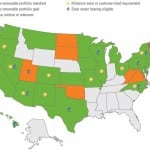COMMENTARY
While the new Qualified Opportunity Zones (QOZ) program initially has drawn widespread interest regarding real estate development, it also appears likely to generate promising opportunities for green energy projects, particularly as the Treasury Department and IRS provide additional guidance on its application.
The QOZ program, enacted in the 2017 tax overhaul, provides significant incentives for investment in economically distressed communities, and the program’s anticipated effects on the commercial real estate market are widely discussed.

Investors in the renewable energy sector are poised to benefit from the program’s marquee incentives. These include deferred tax on reinvested capital gains, a step-up in tax basis that reduces the amount of the recognized gain, and the exclusion of taxable gains from income if the QOZ investment is held for 10 years or more.
For renewable energy, the program will likely provide developers with new sources of investment capital, as the tax incentives should allow investors to accept lower pre-tax returns than may otherwise be required. Moreover, many ideal sites for renewable energy development are located in rural and urban areas that have been designated as QOZs.
It is also possible to combine the QOZ program with the traditional tax incentives available for renewable energy, like the investment tax credit or accelerated depreciation, although doing so presents a wide array of tax-planning complexities.
Anatomy of a Green QOZ
Consider the following hypothetical: A developer forms a limited liability company (LLC) that will become a Qualified Opportunity Fund (QOF). The QOF purchases land located in a QOZ in 2019, forms “ProjectCo,” an LLC treated as a disregarded entity, and contributes the land to ProjectCo. ProjectCo in turn constructs a solar energy facility using contributions made by investors to the QOF. The solar facility is actively engaged in generating electricity that is sold to a utility.
An investor that reinvests gain proceeds in the QOF in 2019 will get a basis step-up of 10% of the gain after five years and an additional 5% increase after seven years. The other 85% will be recognized as gain in 2026. Thereafter, if the investor holds the investment until 2029, it can sell its interest in the QOF without paying tax on the appreciation.
Since the investor can avoid tax on this gain, it has a strong incentive to have most of its return from the investment be in the form of appreciation rather than current cash distributions. Meanwhile, the developer may prefer getting a disproportionate share of operating cash flow in exchange for facilitating a structure that is providing the investor with significant tax benefits. Subject to any anti-abuse rules created by future regulations, the investor and developer should be able to split the economics in the foregoing manner.
The developer would also benefit from the low-cost financing. The investor’s contributions could enable the developer to fully complete project financing without incurring debt or contributing substantial equity. Alternatively, the lower-cost financing could enable projects generating less cash flow to be economically viable for the sponsor.
In addition, raising capital through a QOZ structure could allow a renewable energy project sponsor to finance the project without needing to deal with the complexity, costs, and risks associated with tax equity structures. Moreover, the QOZ program could provide tax benefits for investments in renewable energy property that would not be eligible for federal energy tax credits, such as storage and transmission assets.
Adding Traditional Incentives
It is also possible to combine use of the QOZ program with the separate tax incentives available for renewable energy, possibly using traditional structures involving tax equity investors. Note, however, that this will entail significant complexity in terms of optimizing cash flows, tax benefits, and technical partnership tax issues.
For example, the back leverage in a partnership flip structure could be replaced with an investor seeking to roll over gains into a QOF. An inverted lease structure could be used for a solar investment tax credit project if the tax equity investor is primarily interested in the tax credits available for the project rather than depreciation deductions.
An obvious way to marry the QOZ program with the tax incentives for renewable energy projects would be to form a QOF, where the QOF investor also acts as the tax equity investor. However, the investor may be limited in its ability to use accelerated depreciation deductions or other losses because such an investor initially would have a zero-tax basis in its QOF interest as a result of contributing rolled-over capital gains under the requirements of the QOZ program.
It may be possible to mitigate the deduction limitations if the QOF incurs debt, but there likely would be inefficiencies because there could be a portion of the renewable energy tax incentives that still would go unused or be deferred. The law in this area is still evolving, and this discussion may be changed by the issuance of regulations by the Treasury Department.
Consulting with a lawyer who is well-versed in this field is essential for anyone considering this type of investment. ■
—Michelle Jewett is a partner in the tax group at Stroock & Stroock & Lavan LLP. This commentary reflects regulatory guidance as of April 2019.










